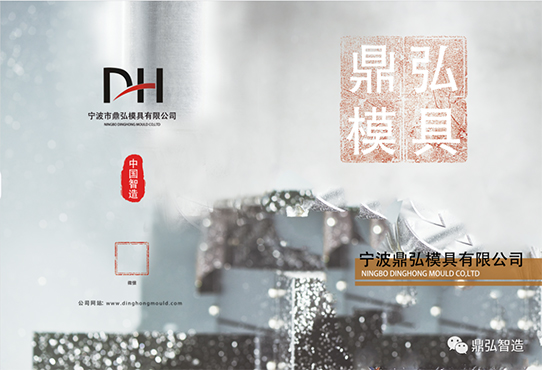
Research progress of non-heat-treated die-casting aluminum alloys for automotive structural parts
1 Introduction
The commercial application of aluminum alloy die castings can be traced back to 1915. After a century of development, more than half of the aluminum alloy castings currently use the die casting process. In the 1990s, a typical case was the all-aluminum body frame of Audi A8, which used aluminum alloy die-casting parts in key joints of the body. It has good toughness while maintaining good strength. Therefore, compared with traditional die-casting parts, such die-casting parts use high-vacuum die-casting process to reduce porosity defects of die-casting parts, and use high-strength and tough die-casting aluminum alloy on the other hand. to obtain excellent comprehensive mechanical properties.
For a long time, the widely used die-casting aluminum alloy for body vacuum die-casting structural parts is AlSi10MnMg alloy. The characteristics of this alloy are to control the low Fe content, and at the same time increase the Mn content to improve the sticking problem. The low Fe/Mn ratio forms a Chinese character, star or polyhedral α-Al(Fe, Mn)Si phase by precipitation, The precipitation of flaky β-AlFeSi phase is avoided, resulting in good toughness. As a heat-treatable die-casting aluminum alloy, the mechanical properties of die-casting materials with different strength and toughness matching can be obtained by adjusting the content of Mg element and the heat treatment system. For example, the vacuum die-casting shock tower and torsion box of a certain vehicle model adopts 0.25%-0.35% Mg content, combined with T7 heat treatment, yield strength ≥ 120 MPa, tensile strength ≥ 180 MPa, and elongation after fracture ≥ 10 %, the performance requirements of the extreme sharp cold bending angle ≥60°, meet the requirements of Self Piercing Rivet (SPR) connection process and crash safety performance.

However, with the rapid development of new energy vehicles, automotive structural parts are rapidly developing towards the direction of integrated, lightweight and high-efficiency design and manufacturing, such as one-piece hot stamping door knockers, one-piece die-casting body, one-piece die-casting sub-frame, etc. For automotive vacuum die-casting structural parts, the heat treatment process of AlSi10MnMg alloy will lead to the problems of deformation and surface blistering of die-casting parts, especially with the continuous enlargement of die-casting parts, the difficulty of subsequent shaping and the scrap rate will be greatly increased. Therefore, on the one hand, non-heat-treated die-casting aluminum alloy materials can be used directly in the as-cast state to avoid the above problems, and on the other hand, it can also reduce the cost of parts manufacturing. In recent years, its development and application have gradually become a research hotspot. At present, the research on non-heat-treated die-casting aluminum alloys for automobile structural parts mainly focuses on two categories: Al-Si series and Al-Mg series. This study focuses on the research progress of these two types of die-casting alloys.
2. Al-Si series non-heat-treated die-casting alloys
Table 2 lists some alloy names and their chemical compositions for non-heat-treated die-cast structural parts. From the perspective of Si content, it can be divided into two categories: high silicon content and low silicon content. Compared with die-casting alloys for heat treatment, the Mg content is significantly lower, and even requires no Mg. In addition, such alloys still have the common characteristics of high-strength and toughness die-casting alloys, that is, low Fe content, high Mn content, addition of Sr element to modify eutectic silicon, etc.
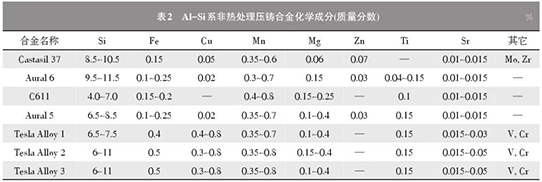
Castasil 37 alloy, or AlSi9MnMoZr, is a non-heat-treatable die-casting alloy developed by Rheinfeld. The alloy does not contain Mg, so it does not have an age hardening effect, while Mo and Zr are added for dispersion strengthening. The Si content of the alloy is close to that of the AlSi10MnMg alloy, so the shrinkage rate is basically the same. When the Mg content in the alloy is different, it will have a certain impact on the yield strength and elongation after fracture of the casting material. Therefore, attention should be paid to controlling the Mg content in production. The mechanical properties of the alloys and the effects of different Mg contents are shown in Table 3. However, based on the research of Rheinfeld Company, increasing the content of Mg element will affect the thermal stability of the mechanical properties of the casting as-cast, which means that the yield strength will gradually increase during service in a certain temperature environment. Therefore, Castasil 37 will limit the content of Mg element to the upper limit. Defined as 0.06%.

Aural 6 alloy, or 375.0, is a non-heat-treatable die-cast alloy developed by Magna Corporation. The chemical composition of the alloy is very similar to the above-mentioned Castasil 37, but the alloy does not add Mo and Zr, but contains a small amount of Mg to obtain a certain strengthening effect. Therefore, combined with the analysis of the effect of Mg element content on the properties of Castasil 37, the thermal stability of the mechanical properties of this alloy casting should also be paid attention to.
Alloy C611 is a non-heat treated die cast alloy developed by Alcoa. The Si content of this alloy is relatively low, because solution heat treatment can improve the morphology of eutectic silicon, and higher Si content can usually be tolerated to obtain good toughness. However, more than 8% Si in the as-cast state cannot be used. The strength of the casting is further improved, but the elongation after fracture will decrease, so it is more appropriate to use a lower Si content for non-heat-treated alloys. The alloy contains a certain amount of Mg, which means that the alloy is not a non-heat-treated material in the strict sense. T5 heat treatment or T85 (coating and baking treatment) for the alloy casting can further improve the yield strength, as shown in Table 4. Show.

Aural 5 alloy, or 374, is a non-heat-treatable die-cast alloy developed by Magna Corporation. The alloy is basically the same as the above C611. Randolf Scott Beals elaborated and studied the design ideas and mechanical properties of the alloy in the patent, and made a detailed comparison with the C611 alloy. Compared with the die-casting alloy Aural2 for heat treatment, the alloy cancels the The solid solution, shaping and aging process can reduce the manufacturing cost. The good plasticity and natural aging stability of the alloy after casting and before coating baking can meet the SPR connection requirements of body structural parts, as shown in Table 4. At the same time, the alloy is similar to C611, the strength will be further improved after coating and baking, and it can also meet the short-cycle thermal stability requirements of 1h at 205℃ and the long-term thermal stability requirements of 1000h at 150℃.
For the first time, Tesla used a 6,000 t large die-casting unit to manufacture the aluminum alloy integrated die-casting rear lower body on its Model Y model. The highly integrated and innovative design of this part also puts forward higher requirements for non-heat-treated die-casting alloys. Stucki Jason introduced the development process of the new alloy in the patent. The first is the requirements for the strength and toughness of the material. The yield strength and ultimate cold bending angle of the target alloy in the as-cast state should be greater than 135 MPa and 24°, respectively, to meet the performance requirements of the casting. At the same time, due to the huge size of the casting, the alloy is also required to have excellent flow properties. The study found that under die casting conditions, when the Si content is more than 6%, continuing to increase the Si content will not significantly improve the fluidity, but will increase the eutectic silicon phase content and affect the toughness of the alloy. Therefore, the alloy controls the Si content at the same time. Meets fluidity and toughness requirements. Usually, adding Cu element can increase the strength, but reduce the ductility and toughness. By controlling the ratio of Cu/Mg to facilitate the precipitation of the AlCuMgSi phase to replace the Mg2Si and Al2Cu phases, the strength can be improved without causing a significant decrease in the ductility and toughness. In addition, the Sr element is added to the alloy to modify the Si phase, and the V element is added to precipitate the spherical AlFeSi(Mn+V) phase, which reduces the flaky iron-rich phase, which is beneficial to the improvement of material toughness. Higher Fe impurity content is tolerated.
3. Al-Mg series non-heat-treated die-casting alloys
Table 5 lists the chemical compositions of some Al-Mg series non-heat-treated die-casting alloys, of which some element contents of some new die-casting alloys are not disclosed, and the element contents in the corresponding positions in the table are blank. It can be seen that it can be subdivided into Al-Mg-Mn, Al-Mg-Si-Mn, Al-Mg-Fe, Al-Mg-Mn-Cu and other types.

Alloy C446F, or 560, is a non-heat-treatable Al-Mg based die-casting alloy developed early by Alcoa. This alloy was used in the door inner panel of Nissan GT-R. The wall thickness of the part is about 2-3mm, and the weight of a single door can be reduced by 5.5kg. The alloy has excellent mechanical properties. However, due to its wide solidification temperature range, the hot cracking tendency during die casting is very high. Therefore, it is not a very good choice for complex parts, especially parts with obvious changes in material thickness. Good choice. Figure 1a shows the change of the liquid phase content of the Al-3.6Mg-1.2Mn-0.12Fe alloy during the cooling process calculated by JmatPro software, in which the liquidus temperature is 642.93 °C, the solidus temperature is 450 °C, and the solidification temperature range is 193 °C.
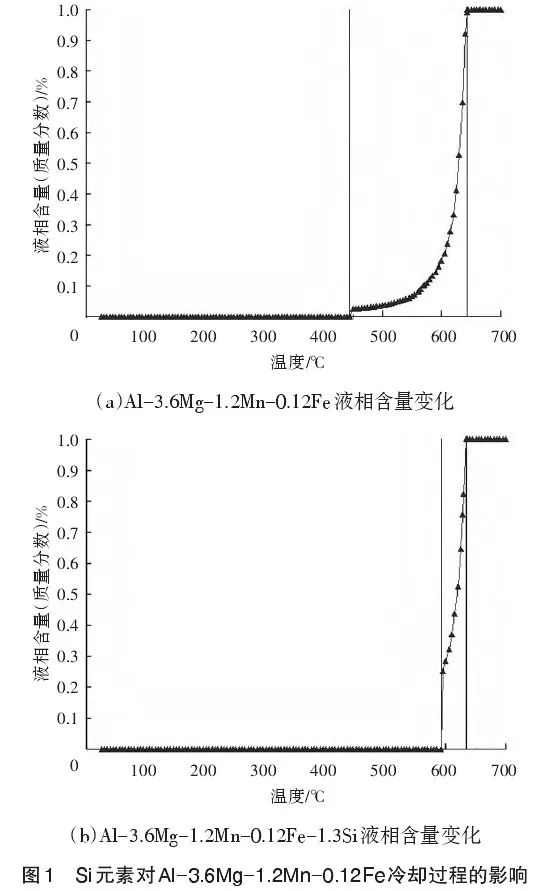
A152/A153 alloy is a new type of die-casting alloy developed by Alcoa on the basis of the above-mentioned C446F alloy to improve hot cracking performance. By adding an appropriate proportion of Si element to the alloy, the solidification temperature range of the alloy can be significantly shortened, as shown in Figure 1b, adding 1.3% Si reduces the solidification temperature range to 43 °C, thereby significantly reducing the hot cracking susceptibility. The alloy was developed by using the method of calculating materials, and the hot cracking sensitivity coefficients of alloys with different compositions were compared and optimized, and the hot cracking tendency index was used for experimental verification. For alloys, Si content of 1.2%-1.6% can significantly improve the hot cracking problem, as shown in Figure 2. The alloy is divided into two grades: A152 alloy with low Mg and A153 alloy with high Mg. Among them, A152 can achieve a yield strength of 150MPa and a tensile strength of 265MPa and an elongation after fracture of 11%. , the tensile strength is 280MPa, and the mechanical properties of the elongation after fracture are 9%.
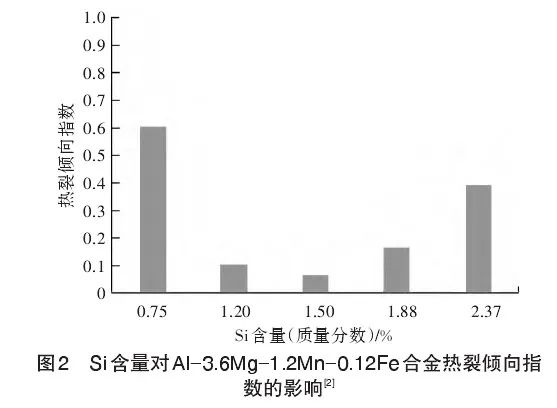
Magsimal 59 alloy, or AlMg5Si2Mn, is a non-heat-treatable die-casting alloy developed by Rheinfeld. In addition to improving the hot cracking properties of the alloy mentioned above, the addition of Si element can also improve the fluidity in the casting process, but Geof-frey sees that the alloy is still difficult to cast with reference to the actual case experience, so it is difficult to cast in North America and other countries. There are few applications in China, and it is only used in some die-casting plants in Europe. In addition, since the mechanical properties of the alloy are closely related to the solidification rate, that is, the α dendrite spacing, the wall thickness has a greater impact on the mechanical properties, as shown in Table 6.
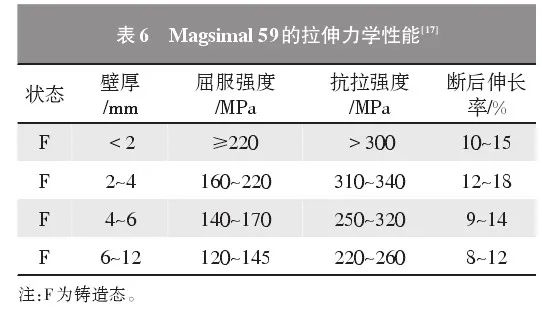
SJTU-Al-Mg-Si-Mn alloy is a non-heat-treated die-casting alloy developed by Shanghai Jiaotong University. Its purpose is to improve the yield strength of the material while maintaining the good toughness of the material. For the Al-Mg-Si-Mn alloy, with the increase of Mg content, the yield strength of the material increases and the fatigue limit increases, but the elongation decreases significantly. Therefore, while increasing the content of Mg and Si elements and adjusting the relative ratio, Ti, Zr, and V alloys were added to improve the structure, and Re/Ca composite modification was introduced to refine the eutectic silicon to obtain a yield strength >180MPa, elongation The mechanical properties of the rate>10%. Similarly, the SJ-TU-Al-Mg-Cu-Mn alloy was strengthened by introducing Cu element, and Y, Er, Ce rare earth elements were introduced to refine the Al2CuMg phase, yield strength>180MPa, tensile strength>320MPa, elongation >8% comprehensive mechanical properties of high strength and high toughness.
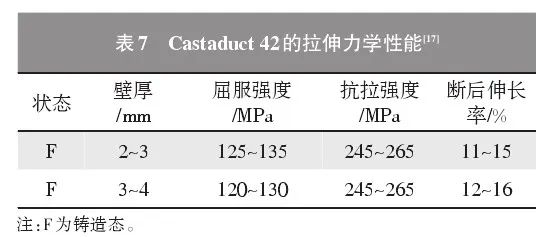
Castaduct 42 alloy, or AlMg4Fe2, is a new type of non-heat-treated die-casting alloy developed by Rheinfeld. Different from the above-mentioned Al-Mg-Mn alloy, this alloy is a new Al-Mg-Fe composition system developed based on the Al-Fe eutectic system, and its high Fe content can avoid the problem of mold sticking during die casting, but at the same time It also causes Si element to become an impurity element that needs to be strictly limited. However, this alloy has a high similarity to the previous C446F, i.e. high Mn or Fe, low Si compositional characteristics, so its castability remains to be verified. The alloy has moderate strength and good plastic toughness in the as-cast state, which can meet the requirements of riveting and crash safety performance of parts. The mechanical properties are shown in Table 7. It is also worth noting that the chemical composition of this alloy is very similar to 5XXX series wrought aluminum alloys commonly used in body stamping structural parts, such as 5182 (AlMg4.5Mn0.4) alloy, and the design of alloy composition with high Fe content can It is relatively easy to realize the recycling of such waste aluminum, reduce the proportion of A00 electrolytic aluminum used, and thus greatly reduce the carbon emission of aluminum alloy body structural parts.
4 Conclusion
With the increasingly severe demand for energy saving and emission reduction in automobiles, the penetration rate of aluminum alloy vacuum die castings in key automotive structural parts continues to increase due to its integration, lightweight, and good strength and toughness. However, with the continuous improvement of the integration degree of die-casting parts, especially the concept and application of Tesla's integrated body forming technology, the traditional AlSi10MnMg alloy cannot meet the demand due to the necessity of heat treatment, so the research on new non-heat-treated die-casting aluminum alloys is continuously promoted. With regard to application, the current related research and application cases are mainly concentrated in two categories: Al-Si system and Al-Mg system.
For vehicle enterprises, aluminum alloy die castings for automotive structural parts are different from traditional die castings. The connection process in the manufacturing process and the vehicle performance during service have higher requirements on the comprehensive mechanical properties of the die castings, especially the toughness. The current Al-Si and Al-Mg alloys generally have the characteristics of moderate strength and toughness. With the continuous improvement of the integration and lightweight design requirements of aluminum alloy die-casting structural parts, the development of new die-casting alloys should develop in the direction of improving strength and/or toughness, while having good fluidity and casting properties.
For aluminum processing enterprises, due to its low Fe content, die-casting aluminum alloys for automotive structural parts, even if high Mn elements are added, the die-casting alloys are still seriously eroded to the mold, and the mold life is significantly reduced compared to traditional die-casting parts, which leads to The manufacturing cost of automobile die-casting structural parts is obviously high, especially with the continuous enlargement of die-casting parts, the challenge to the mold is getting bigger and bigger. At the same time, low-Fe die-casting alloys must be prepared with pure aluminum ingots, and the cost of raw materials and carbon emissions are significantly higher than those of traditional die-casting parts. Therefore, research and development of new high-strength and tough die-casting alloys with higher tolerance to Fe elements are needed to promote regeneration. The application of aluminum alloys in automobile die-casting structural parts is not only beneficial to the cost control of parts, but also greatly reduces carbon emissions in the stage of raw material acquisition, thereby significantly improving product competitiveness.

地址:浙江省宁波市北仑区大碶沿塘河路6号
孙跃君:13806631860
王式雍:15958891460 / 15058297768
电话:0574-86140828 / 0574-86140818
传真:0574-86140828